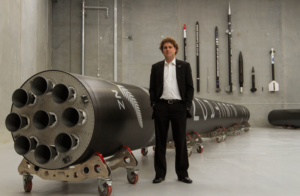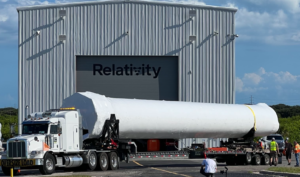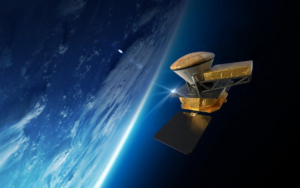
Blue Origin Is Preparing For BE-4’s Busiest Year Yet!
While Blue Origin’s BE-4 engine hasn’t had the smoothest development, the current state of the engine looks very promising. For the last few months now, we have seen a combination of increased testing, production, and use during an actual launch. Just a few days ago, Blue Origin revealed that for the first time, they completed a BE-4 hot-fire at Test Stand 4670 in Huntsville.
For a while now the company has been working to refurbish and prepare this historic site. With this now complete, another large asset in the form of an additional test stand has been added to the company’s arsenal. Here I will go more in-depth into the new test, engine production, BE-4s significant demand, and more.
New Test Site

A few days ago on the 1st, Blue Origin tweeted saying, “A louder rumble in Rocket City! We just completed our first BE-4 engine hotfire test at the historic Test Stand 4670 in Huntsville. We also continue to test BE-4 engines at our Texas facility. The BE-4 engine produces 550,000 pounds of thrust and is our most powerful engine yet.” This included a short video highlighting the hot fire and use of the completed test stand.
This has been a long time coming with initial plans to utilize this site beginning years ago. In 2020, for example, Blue Origin opened its rocket engine production facility in Huntsville, AL. At the time, in a statement, the company was quoted saying, “The world-class engine manufacturing facility in The Rocket City will conduct high rate production of the BE-4 and BE-3U engines. These engines will undergo testing at NASA Marshall Space Flight Center on the historic Test Stand 4670.”
Blue Origin also pointed out that they would add more than 300 jobs to the local economy with an investment of over $200 million in the facility. By the middle of 2022, Blue Origin installed the first BE-4 engine on the test stand. This was done to complete some commissioning tests among other prep. Another year and a half went by and finally, the company was ready. Even though Blue Origin already has a test stand in Texas which they always used for BE-4 tests, they now have a second option. It’s possible we see the number of tests increase as more and more engines come out the door. It also acts as a very convenient addition with its proximity to the engine manufacturing facility. This should improve the time it takes to certify engines and in turn, produce them.
Looking at the current and future forecast of BE-4 demand, the company needs a lot of engines and soon. In just the last month alone, we have seen both New Glenn flight hardware and the first launch of ULA’s Vulcan. Both vehicles require the engine on their first stage, 7 for New Glenn and 2 for Vulcan. For New Glenn, not only has flight hardware been spotted but the company has confirmed they are planning the first flight of the vehicle late this year. Besides the 7 engines needed for that first test article, it also means the beginning of a consistent BE-4 engine demand from New Glenn. Even though the vehicle is reusable and in theory should only need 7 engines for each booster, it still is going to add up. For one, it’s very possible that on initial flights the booster fails to land and the hardware is lost. On the other hand, even if each launch is perfect, they will be making quite a few boosters which each require 7 more engines.
As for ULA and Vulcan, since the first flight was a success, ULA’s schedule is about to get very busy. The company’s CEO Tory Bruno has said, “We have to ramp up, before the end of 2025 we expect to be really at a tempo, which is flying a couple of times a month, every two weeks.” To add to this, Vulcan has 38+ secured launches with this vehicle alone. A good portion of which will happen within the next few years. Since Vulcan is expendable, every launch means two more BE-4 engines are needed. It’s possible the total 38 launches require 76 BE-4 engines. Even in the next few months, we are expecting another Vulcan launch. Something expected to only increase over time.
The BE-4 Engine

The BE-4 engine is quite unique, so much so that Vulcan and New Glenn will benefit from its design significantly. Standing at around 12+ feet tall, BE-4 is one of the most powerful liquefied natural gas (LNG) fueled rocket engines ever developed. Using an oxygen-rich staged combustion cycle, BE-4 is capable of producing 2,400 kN (550,000 lbf) thrust with deep throttle capability.
Blue Origin points out that BE-4 was designed from the beginning to be a medium-performing version of a high-performance architecture. They are quoted saying “It’s a conscious design choice made to lower development risk while meeting performance, schedule, and reusability requirements. With our hardware-rich approach, multiple developmental units and redundant test stands enable a high test tempo and rapid learning.” The choice of propellant was also a big deal when designing the engine. They ended up choosing LNG because it is highly efficient, low cost and widely available. Unlike kerosene, LNG can be used to self-pressurize its tank. Known as autogenous repressurization, this eliminates the need for costly and complex systems that draw on Earth’s helium reserves. LNG also possesses clean combustion characteristics even at low throttle, simplifying engine reuse compared to kerosene fuels.
In New Glenn’s case, this is immensely important. The combination of the engine’s propellant and conservative performance are all aimed at reusability. The goal is for New Glenn to land and the refurbishment process to be relatively simple and quick. We won’t know for sure how smoothly this process goes until New Glenn starts flying, but this at least is the plan.
In terms of development, the BE-4 engine has come a long way. Blue Origin began work on the BE-4 over a decade ago in 2011. Years later in 2019, the engine had managed to acquire a total of 1800 seconds of hot fire testing on ground test stands, but had yet to be tested above 1.8 meganewtons (400,000 lbf) pounds of thrust, about 73% of the engine’s rated thrust of 2.4 MN (550,000 lbf). Around that time, Blue Origin was troubleshooting the 75,000-horsepower pumps that bring fuel to the BE-4’s main combustion chamber. Eventually, they managed to deliver the first engines to ULA.
The most recent hiccup was an engine explosion on the test stand. It was reported that the engine detonated about 10 seconds into a hot-fire test. Tory Bruno commented at the time, “This engine failed ATP.” This suggests that the issue was caused by bad workmanship and shouldn’t affect the engines that already passed these tests. He also pointed out that anomalies like these are “Relatively routine at the beginning of a production run. Later, however, as the automated shutdown systems get well-tuned in, they become rare. He finished with one last comment that the issue is, “Way less interesting than it sounds. Just an ATP failure. They happen. That’s why we acceptance test each component coming off the line before accepting delivery.” This happened back in June of last year and there haven’t been any issues since.
Back in late 2022, we first got a hint that production was starting to ramp up when the company said in a report that “Dozens of these engines are now in production to support a large and growing demand for civil, commercial, and defense launches.” Next in April, they released footage inside the regen nozzle room in the Huntsville engines factory. Here dozens of BE-4 engines can be seen in early production. Since the engines demand depends on both Vulcan and New Glenn, certain future developments could change this.
For example, the idea of Vulcan resuing its BE-4 engines has been talked about. Tory Bruno said, “In terms of our engine recovery, that is going to happen within a handful of years. I don’t want to say exactly when because it’s part of the contract we have with one of our customers at this time, and we’re not releasing the details of that. But it will take a couple of years to actually be reusing the engine.” He finished by saying, “You will see us potentially do more demonstrations. We’ll be collecting environmental data to see booster experiences. We’ll recover engines and look at them. And then eventually we’ll have the confidence to recover them, inspect them, and then reuse them. And so that will happen in this window of a few years, but it’s too early at this moment for me to say exactly when. But you’ll see that activity ramp up.”
When asked about the economics of the recovery plan, Tory Bruno responded saying, “Breakeven in 2 to 3 flights fast” In addition, in April 2021 CEO Tory Bruno said that the additional launches purchased by Amazon for the Kuiper satellite constellation would require a higher launch cadence and that this provided support for the business case to go forward with the reuse concept. The plan would use a HIAD, or Hypersonic Inflatable Aerodynamic Decelerator. After separation, the nose assembly extends to position the HIAD such that it will clear the separation plane when inflated. From here, it would continue through Earth’s atmosphere before parachute deployment. This would slow down the two BE-4s and additional technology significantly before a planned soft water landing. Here they would float on an inflatable aeroshell before being recovered by ULA and taken back to land for refurbishment.
Conclusion
Blue Origin is continuing to work on the BE-4 engine as New Glenn and Vulcan start to launch. For the first time, the company just tested a BE-4 engine at the Hunstville test stand. We will have to wait and see how it progresses and the impact it has on the space industry.



